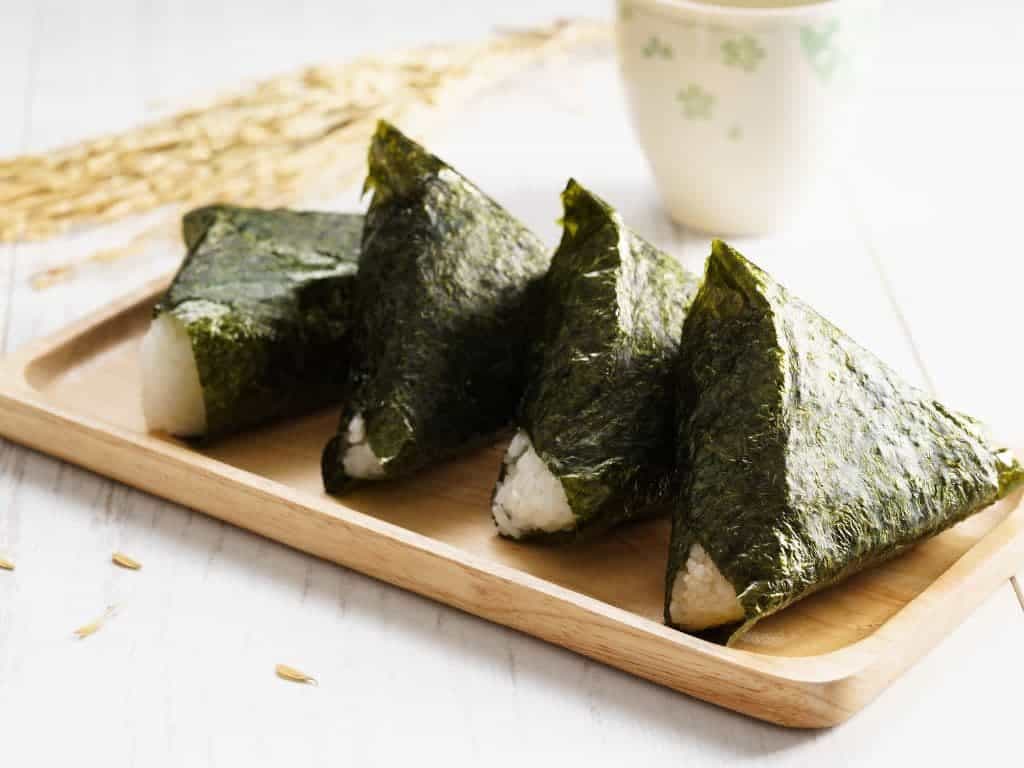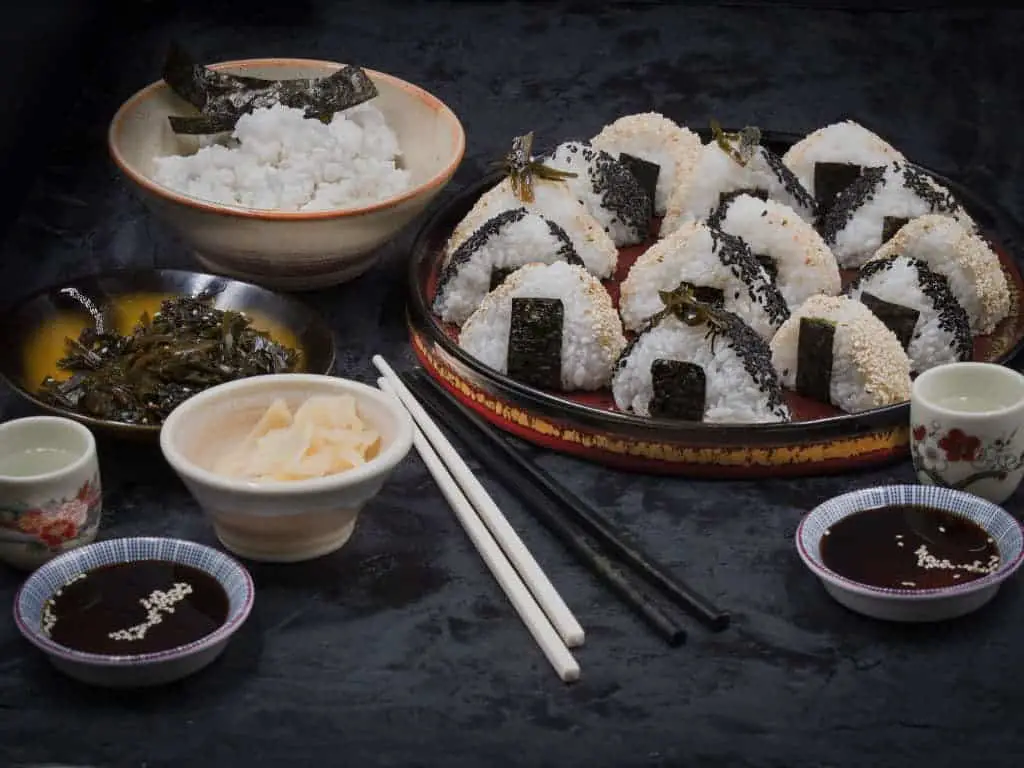Wondering about the distinction between the delightful, bite-sized wonders known as onigiri and their equally delectable counterpart, sushi?
Onigiri and sushi are separate dishes in Japanese cuisine. The main difference between onigri and sushi is that onigri is a type of rice ball that is often wrapped in nori while sushi is a type of dish made with vinegared rice and other ingredients, such as seafood, vegetables, and sometimes tropical fruits. Onigiri is usually a snack or light meal, while sushi is often a more substantial meal.


In this blog, I’ll explore the world of rice balls and fish rolls and figure out if onigiri can really be called sushi. So grab your chopsticks, and let’s get started!
Onigiri vs. Sushi: The Great Japanese Snack-Off!
Onigiri and sushi are related by their use of vinegared rice and fillings. But they have distinct personalities. They may share a resemblance.
But their differences in preparation and purpose make them unique and separate entities.
Here is what Onigri looks like:

Here is what sushi looks like:

No matter if you’re a fan of the humble onigiri or the fancy sushi, these scrumptious delights are hard to resist! Let’s break down their individual quirks:
- Onigiri is typically made with plain or lightly seasoned white rice.
- Sushi rice is flavored with vinegar, sugar, and salt.
- Onigiri is an adventurous snack that’s often filled with savory surprises like pickled plum or grilled salmon.
- Sushi is typically topped with raw fish, cooked seafood, or vegetables.
- Onigiri is crafted by shaping the rice into a ball or triangle with hands or a special mold, then fill it with anything from umeboshi to tuna salad.
- It’s like a little present wrapped up in nori (dried seaweed) and ready to be devoured.
- Sushi, on the other hand, is a work of art. The rice is seasoned to perfection before being adorned with sashimi, cooked seafood, veggies, or egg.
- It’s rolled up tight, wrapped in nori or soy paper, and presented like a masterpiece.
- Sushi is often served as part of a larger meal.
- Onigiri is a more casual snack.
- Sushi is often eaten with chopsticks.
- Onigiri is typically eaten by hand.
With their little sizes, Onigiri and sushi might look like they’re from the same squad. But they’re actually as different as day and night. From what goes in them to how they’re made, these two bites are worlds apart.
Two Peas in a Pod: Similarities between Onigiri and Sushi
Onigiri and sushi are often compared to two peas in a pod. Let’s check out the three main similarities between these two delectable delights: shared ingredients, shapes, and sizes that look like they could be related and their convenient snack status.
Common Ingredients
One of the main things onigiri and sushi have in common is their love for using similar ingredients – primarily rice. However, the type of rice used can be slightly different. Sushi rice is shorter and more seasoned, with a tangy twist of vinegar, salt, and sugar. Meanwhile, onigiri rice is more of a plain, short-grain rice.
Another shared ingredient is nori or dried seaweed. Nori gets wrapped around sushi rolls like a cozy blanket, while onigiri likes nori wrapped around the rice ball for extra flavor and texture.
You’ll also find some other familiar ingredients in both these tasty treats, like pickled plum, tuna, salmon, other seafood, cucumber, avocado, and seasonings like soy sauce, wasabi, and sesame seeds.
Similar Shapes and Sizes
Do you know what’s more similar between onigiri and sushi? They share shapes and sizes. These two munchies are small, easy to handle with your hands, and perfect for those who are always on the go. Onigiri is a triangle or ball-shaped one. At the same time, sushi is the cylindrical or rectangular block-shaped one.
Onigiri and sushi are not just delicious. But they’re also bite-sized wonders that can be devoured in just a few nibbles. They’re the superheroes of snacks. They provide quick sustenance when you’re running out of time. Plus, their shape and size make them the ultimate companions for picnics and lunch boxes. So pack them up, and take them on your next adventure!
Convenience as a Snack
Let’s talk about Japan’s snack game! Onigiri and sushi are popular in the convenience store scene.
Whether you’re rushing through a train station, Or just need a quick bite. Onigiri and sushi got you covered. Plus, they don’t even need to be heated up. This makes them the perfect snack for those who are always on the go.
Guess what? You can prepare both onigiri and sushi in advance. And store them in the fridge. That means you can have a handy snack waiting for you when you’re running late and don’t have time to whip up a meal. No wonder they’re so popular in Japan. And even beyond!
Sure, onigiri and sushi are different in some ways. But they’ve got some similarities too. They both use common ingredients and share a similar shape and size. And they are convenient snack options. That’s why they’re both beloved in Japanese cuisine and everywhere!
Final Thoughts
So, it turns out the question of whether onigiri is sushi is a bit of a head-scratcher. Onigiri and sushi have a lot in common – they’re both delicious, convenient snacks made with rice and often come in little sizes. But there are also some differences in the way they’re made and the ingredients used.
It’s important to appreciate the cultural significance of both onigiri and sushi. Onigiri has been a staple of Japanese cuisine for centuries. It has been providing a filling snack for travelers and workers on the go. Sushi, on the other hand, has evolved from a simple method of preserving fish to a work of culinary art.
Some folks argue that onigiri should be considered a type of sushi. They cite the use of vinegar and fillings. Others, however, argue that the lack of raw fish and different preparation methods make it a completely separate food. It’s all a matter of personal opinion, perhaps.
In the end, whether you consider onigiri to be sushi or not, one thing is for sure – they’re both delicious and worth trying. So, go ahead and indulge in some ricey goodness, whatever you want to call it!
